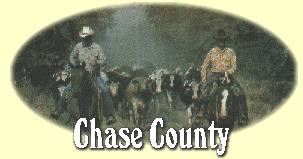Chase County, KS
 Q: What do 100,000 cattle, Knute Rockne, Samuel N. Wood and limestone have in common?
Q: What do 100,000 cattle, Knute Rockne, Samuel N. Wood and limestone have in common?
A: Chase County, Kansas.
Travel Route 177 to Chase County and you'll be deep into the heart of the Flint Hills where the sky expands and the land begins to rise and fall like waves on a sea of grass. Much of the land in an area 30 to 40 miles wide along the byway has remained unchanged for thousands of years.
Two miles north of Strong City, the Tallgrass Prairie National Preserve protects a portion of pristine prairie. This fragile ecosystem is home to 40 species of grasses, 200 species of birds, 30 mammals, plus reptiles, amphibians and as many as 10 million insects per acre.
Further south you'll discover the magnificent residence of the late 19th century cattle baron, Stephen F. Jones at the Tallgrass Prairie National Preserve. The historic ranch headquarters features a Second Empire-style mansion made of hand-cut native limestone, as well as an enormous three-story barn. The Lower Fox Creek School, a traditional one-room schoolhouse, sits on a nearby hilltop.
Cottonwood Falls is home to the Chase County Courthouse, the oldest courthouse still in use in the state. Built in 1873 with native limestone and walnut, this Second Empire-style building is an architectural jewel shining in the Flint Hills.
For years Chase County has been considered the heart of the Flint Hills, with the gently rolling hills and vast sea of grass extending in a narrow band from Oklahoma to near the Nebraska border. The Kansas Flint Hills remain as the only extensive area of tallgrass prairie in the eastern Great Plains.
Each spring about 100,000 stocker cattle come to the Bluestem Grasslands of Chase County to graze for a period of 90 to 150 days. These cattle come from all areas of the U.S. and Mexico including Texas, Oklahoma, Missouri, Arkansas, Kentucky, Tennesseee, Florida and Colorado.
Chase County was named for Civil War Era statesman Salmon P. Chase. As a senator from Ohio, he voted against the Kansas-Nebraska bill which made Kansas a territory in 1854. Later he was Secretary of the Treasury in the Lincoln cabinet and also Chief Justice of the Supreme Court.
Explore Chase County
Knute Rockne Memorial Marker
On March 31, 1931, the plane carrying Notre Dame's famous football coach, Knute Rockne, and H.J. Christen, J.H. Happer, W.B. Miller, Charles A. Robrecht, Spencer G. Goldwaite, Robert Frye, and Jess Mathias, crashed near Bazaar in Chase County, losing all lives.
Strong City, KS MemorialsFlint Hills Rodeo
The Flint Hills Rodeo is the oldest consecutively run professional rodeo in the state of Kansas. The top cowboys and cowgirls from throughout the midwest compete each year for over $50,000 in six traditional rodeo contests. Plan a spring trip to the "heart of the Kansas Flint Hills"
Strong City, KS RodeosTallgrass Prairie National Preserve
In 1994 the National Park Trust purchased the 10,894
Strong City, KS National ParksChase County State Fishing Lake
Chase State Fishing Lake and Wildlife Area lies in the center of the scenic Flint Hills region of Kansas. The 109-acre lake was constructed in 1964. The lake and surrounding 383 acre wildlife area are owned and managed by the Kansas Department of Wildlife and Parks.
Strong City, KS RecreationChase State Fishing Lake
Chase State Fishing Lake and Wildlife Area is located 3 miles from Strong City and 1.5 miles west of Cottonwood Falls in the center of the scenic Flint Hills region of Kansas. The 109-acre lake was constructed in 1964. The lake and surrounding 383
Cottonwood Falls, KS RecreationCamp Wood YMCA
CAMP WOOD YMCA is a precious gem of the Kansas Flint Hills. Where else can you experience the many treasures offered by the Tallgrass Prairie. Situated on 630 acres of native grassland, Camp Wood is bordered on the north by the Cottonwood River, with our 19
Cottonwood Falls, KS Outdoor ActivitiesSwope Park
Swope Park consist of 30 acres and includes the Municipal Swimming Pool, Chase County Fair Grounds, Shelter Houses, Lighted Athletic Fields and Playground Equipment.
Cottonwood Falls, KS ParksChase County Courthouse
[Chase County Courthouse] The picturesque Chase County Courthouse, the oldest in use in Kansas today, was built during 1871-73 in the Renaissance style of the Louis XIII period. The 113
Cottonwood Falls, KS Historic CourthousesCottonwood River Dam & Bridge
Listed on the National Register of Historic Places in 1985, the area at the Cottonwood Dam is a place to enjoy watching the fishing for catfish on the bridge. Stop and listen to the relaxing sound of the falls. North of the river is Bates Grove Park which offers picnic facilities.
Cottonwood Falls, KS National RegisterThe Santa Fe Depot
The original depot burned in 1902 and was replaced in 1903. In 1913, due in part to the very heavy passenger and freight traffic, a new brick depot trimmed in native cut limestone was built for a cost of $20,000
Strong City, KS Railroad History1875 Drinkwater & Schriver Flour Mill
The 1875 Drinkwater & Schriver Flour Mill is located on the Cottonwood River at Cedar Point. Flour was milled for the area and also shipped to Eastern bakeries until the 1937
Cedar Point, KS Pioneer Life